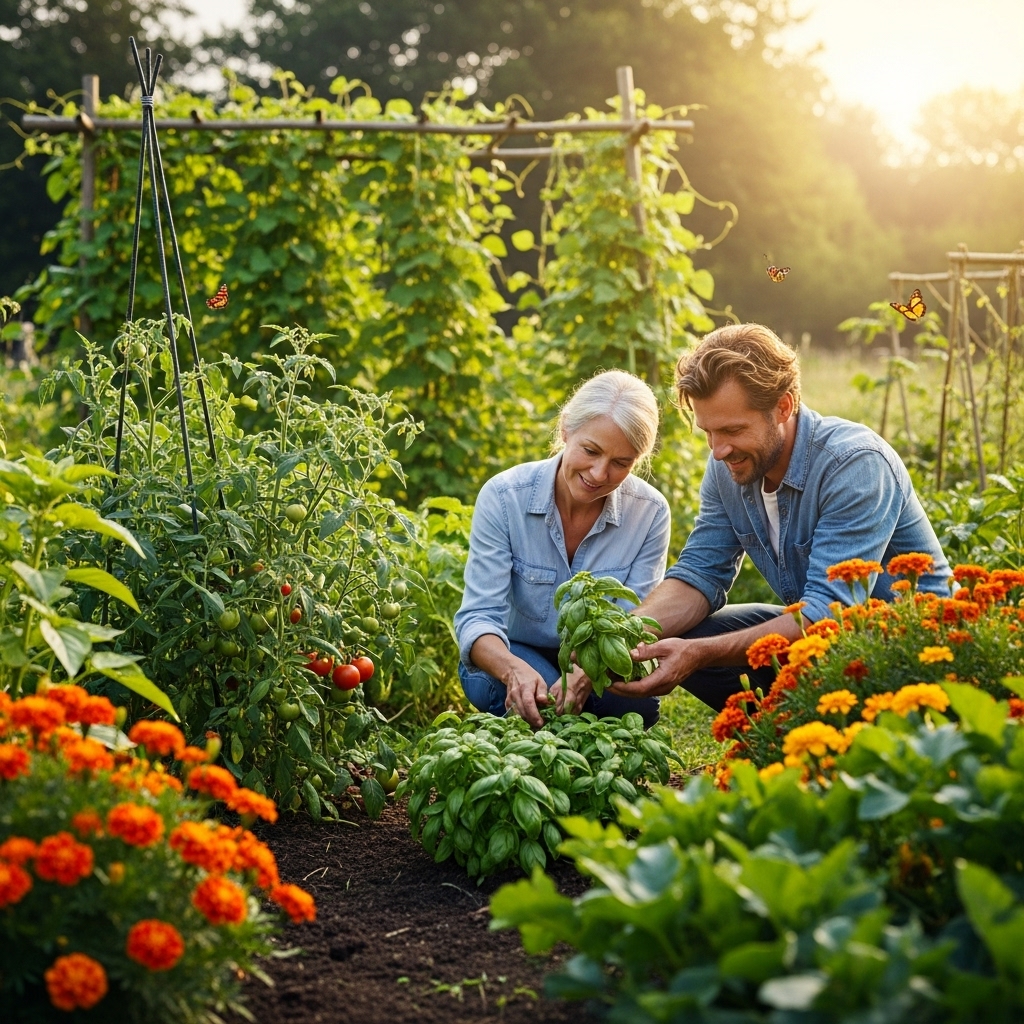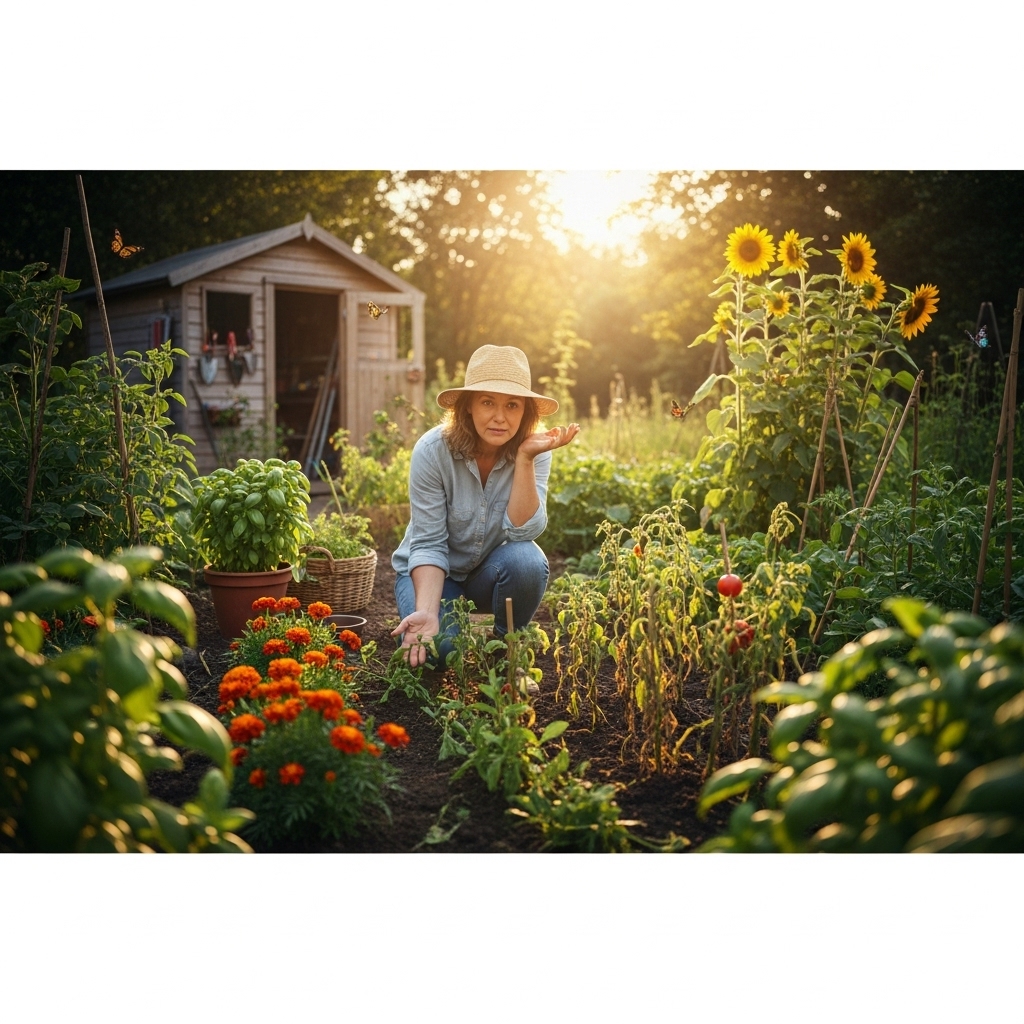Companion planting is a fascinating way to enhance the health and productivity of my garden. However, I’ve learned that there are common pitfalls that can undermine my efforts. Let’s dive into the mistakes I’ve encountered and how to avoid them for a thriving garden.
Understanding Companion Planting

Companion planting involves strategically placing different plants together to promote growth, repel pests, and improve overall health. I’ve found that this gardening technique not only enhances my plants’ vigor but also creates a more balanced ecosystem in my garden. However, when I first started, I made several mistakes that could easily have been avoided with a bit of research and planning.
Mistake 1: Ignoring Plant Compatibility
One of the biggest errors I made was not thoroughly researching plant compatibility. Certain plants thrive together, while others can inhibit growth or attract pests. For instance, I once paired tomatoes with corn, only to discover that corn can attract the tomato hornworm. The lesson I learned was to always check compatibility charts or guides before planting. I now consult resources that list which plants are beneficial companions and which ones should be kept apart.
Mistake 2: Planting in the Wrong Location
Another mistake I often made was misjudging the sun and shade requirements of my plants. Some plants prefer full sun, while others thrive in partial shade. I remember planting my lettuce in a sunny spot without realizing it would bolt quickly due to the heat. Now, I carefully consider the light requirements of each plant and choose their locations accordingly. This way, I can ensure that every plant gets the optimal conditions it needs to flourish.
Mistake 3: Overlooking Soil Requirements
Soil health is crucial for any garden, yet I frequently neglected this aspect by not considering the specific soil preferences of my plants. Some plants thrive in acidic soil, while others prefer alkaline conditions. For example, I planted my basil near my rhododendrons, which prefer acidic soil. The result? My basil struggled to grow. Since then, I’ve made it a habit to amend my soil based on the needs of the plants I’m growing. Conducting soil tests before planting has become a crucial step in my gardening process.
Mistake 4: Not Accounting for Growth Habits
I also learned the hard way that I needed to account for the growth habits and sizes of the plants I was pairing. Some plants grow tall and may overshadow their shorter companions. I once planted cucumbers next to my carrots, only to find that the cucumbers took over, blocking sunlight from the carrots. Now, I consider the height and spread of each plant when planning my garden layout. I’ve also found that using vertical gardening techniques with trellises can help maximize space and ensure that all plants receive adequate sunlight.
Mistake 5: Forgetting to Rotate Crops
Crop rotation is a fundamental practice that I initially overlooked. I felt that if companion planting worked well one season, I could repeat the same combinations the following year. However, this led to nutrient depletion and pest buildup in my soil. Now, I diligently rotate my crops each year, ensuring that I move my companions around to prevent these issues. This not only helps to maintain soil health but also keeps my plants more resilient against pests.
Mistake 6: Neglecting Continuous Observation
One of the most significant mistakes I made was failing to observe my plants continuously. Companion planting is not a “set it and forget it” approach. I’ve learned to pay close attention to how my plants interact with each other. For example, I noticed that my marigolds were effective at deterring certain pests, but I didn’t realize that they were also attracting beneficial pollinators. By observing my garden regularly, I can make adjustments as needed to improve plant health and productivity.
Mistake 7: Ignoring Pest Management
I once assumed that companion planting would completely eliminate the need for pest management. While it’s true that some plants can repel pests, I found that I still needed to monitor my garden and take proactive measures when necessary. I’ve started incorporating beneficial insects, such as ladybugs and lacewings, to help manage pests naturally. Additionally, I regularly check for signs of pest infestations and act swiftly to address them, keeping my garden healthy and productive.
In my journey through companion planting, I’ve encountered numerous challenges and mistakes. By learning from these experiences, I’ve developed a deeper understanding of how to create a thriving garden. As I continue to refine my approach, each season offers new lessons and opportunities for growth. I look forward to sharing more insights and strategies in the coming sections, focusing on more common mistakes and practical solutions to enhance my gardening journey.
Exploring More Companion Planting Mistakes

As I continue to navigate the world of companion planting, I’ve come to realize that my gardening journey is one of constant learning. Beyond the earlier mistakes I’ve mentioned, there are several other pitfalls that I’ve encountered along the way. Each one has taught me valuable lessons that have significantly improved my gardening practices. Here are some additional mistakes I’ve faced and how I’ve addressed them.
Mistake 8: Rushing into Planting
In my eagerness to get my garden started, I often rushed into planting without giving myself enough time to prepare the soil or plan the layout. This haste led to overcrowded spaces and inadequate soil amendments. I vividly remember a season when I hurriedly planted several crops only to find them competing for nutrients and space. Now, I’ve learned the importance of taking the time to plan my garden thoroughly before planting. I create a detailed layout that considers plant compatibility, growth habits, and space requirements, ensuring that I set my garden up for success right from the start.
Mistake 9: Ignoring Seasonal Changes
Another mistake I made was failing to consider how seasonal changes affect my garden. Some plants thrive in cooler temperatures, while others prefer the warmth of summer. In my first spring garden, I planted warm-season crops too early, only to have them struggle against the lingering cold. Now, I pay close attention to my local climate and seasonal patterns. I’ve learned to plant cold-resistant varieties earlier in the spring and wait until the frost risk is gone before introducing delicate plants. This way, I can maximize my garden’s potential throughout the growing season.
Mistake 10: Underestimating Water Requirements
I also underestimated the varying water needs of different plants. Early on, I applied a one-size-fits-all approach to watering, which wasn’t effective. I remember my squash plants wilting while my carrots were waterlogged. Now, I carefully assess the moisture preferences of each plant and adjust my watering schedule accordingly. I’ve implemented a drip irrigation system that helps deliver water directly to the roots, ensuring that every plant receives the right amount without waste. This adjustment has not only improved plant health but also reduced my overall water consumption.
Mistake 11: Using Synthetic Fertilizers
In my quest for quick results, I initially relied on synthetic fertilizers to boost plant growth. However, I soon noticed adverse effects, including nutrient imbalances and diminished soil health. After some research, I discovered the benefits of organic fertilizers and compost. Now, I focus on enriching my soil with natural amendments, such as compost and well-rotted manure, which promote long-term soil health and encourage beneficial microorganisms. This shift not only supports my plants but also contributes to a more sustainable gardening practice.
Mistake 12: Being Inflexible with Plant Choices
At times, I’ve been too rigid with my plant choices, sticking to the same varieties year after year. This inflexibility can lead to stagnation in my garden and a lack of diversity. I realized that experimenting with new plant varieties can yield exciting results, both in terms of flavor and pest resistance. Now, I make it a point to try at least one new plant each season, whether it’s a different heirloom tomato or a less common herb. This not only keeps my gardening experience fresh but also helps me discover new favorites that thrive in my garden.
Mistake 13: Forgetting to Mulch
Initially, I overlooked the benefits of mulching in my garden. I didn’t realize that a proper layer of mulch could help retain moisture, suppress weeds, and regulate soil temperature. It wasn’t until I struggled with weed overgrowth that I decided to give mulching a try. Now, I make it a regular part of my gardening routine, using organic materials like straw or wood chips. The results have been remarkable; my plants are healthier, I spend less time weeding, and I can better manage moisture levels in the soil.
Mistake 14: Neglecting Plant Diversity
Lastly, I learned the importance of plant diversity in my garden. Early on, I focused too heavily on a few staple crops, which made my garden susceptible to pests and diseases. I quickly discovered that a diverse garden ecosystem is more resilient. By incorporating a wider variety of plants, I not only enhance the beauty of my garden but also create a more balanced environment that naturally deters pests. I now make it a priority to include various herbs, flowers, and vegetables that complement each other, enriching my garden’s biodiversity.
Through each of these experiences, I have gained invaluable insights into the art of companion planting. Every mistake has led me to refine my techniques and deepen my understanding of the complex relationships between plants. As I continue to learn and grow, I’m excited to explore even more strategies that will help me cultivate a thriving garden.
Final Thoughts
Gardening is an ongoing journey that invites both challenges and rewards. By reflecting on my past mistakes and embracing new methods, I’ve developed a more harmonious and productive companion planting approach. I look forward to sharing more lessons learned as I navigate the ever-evolving landscape of my garden, continually striving for balance and vitality in every growing season.
